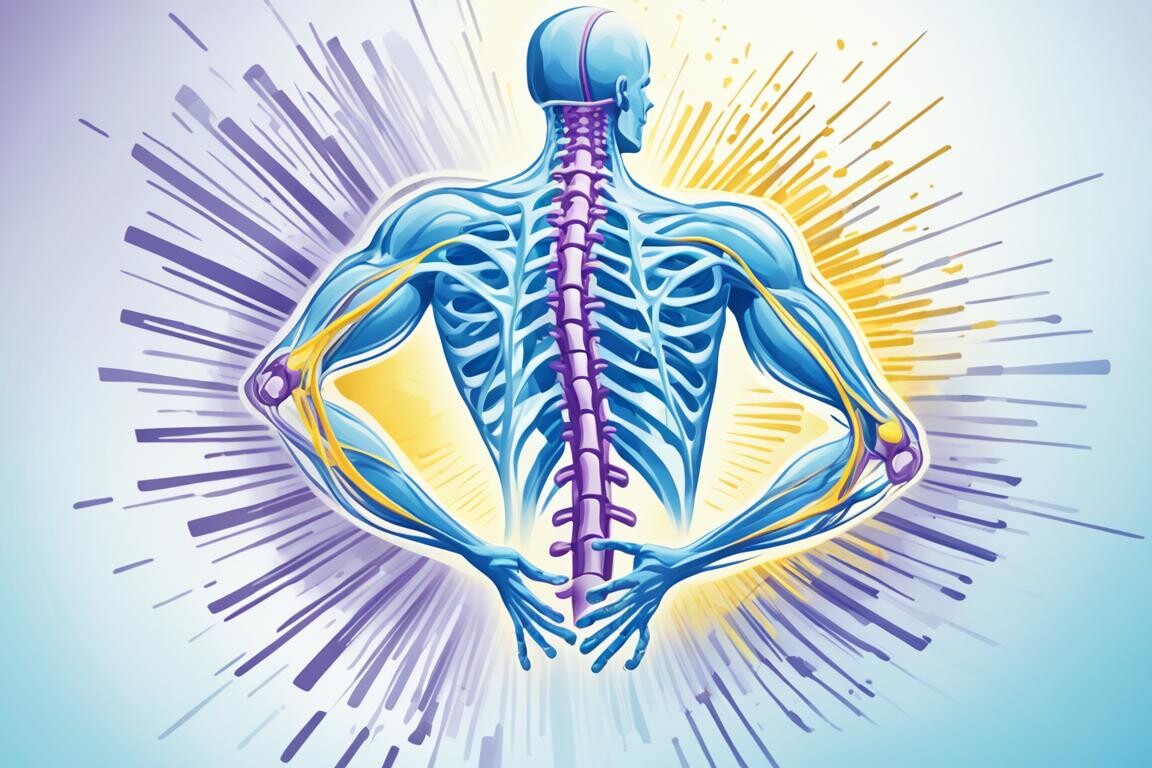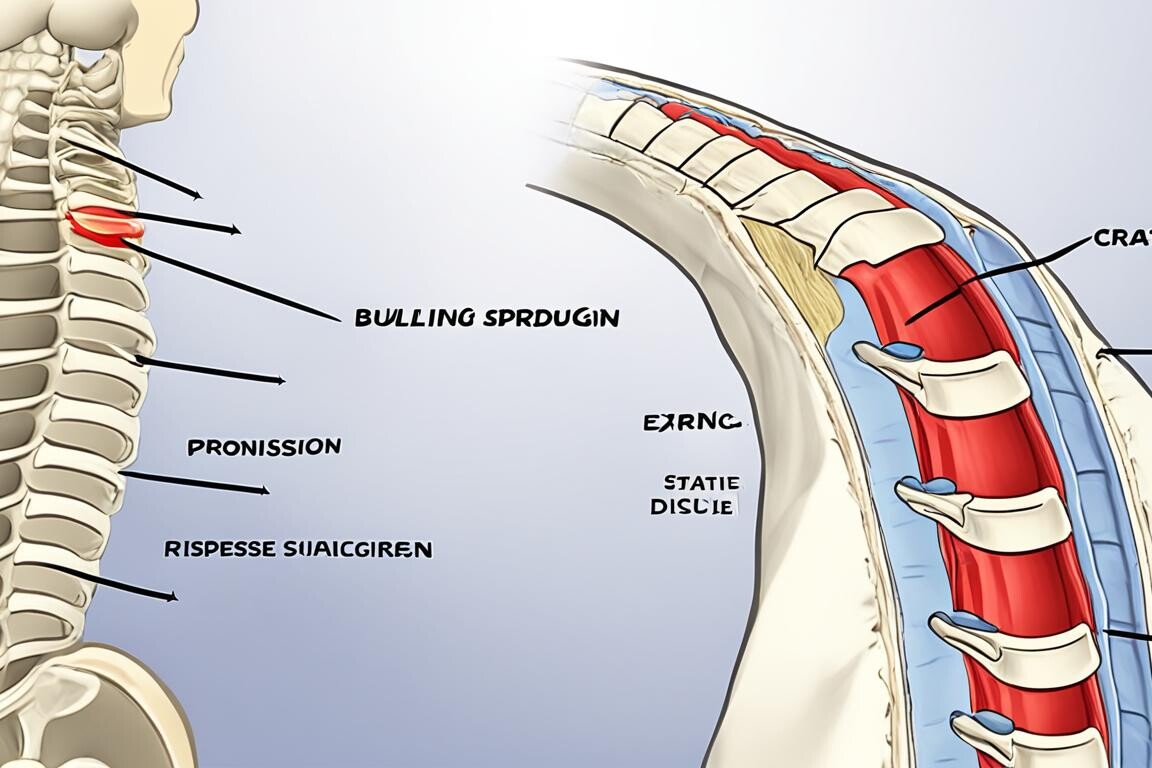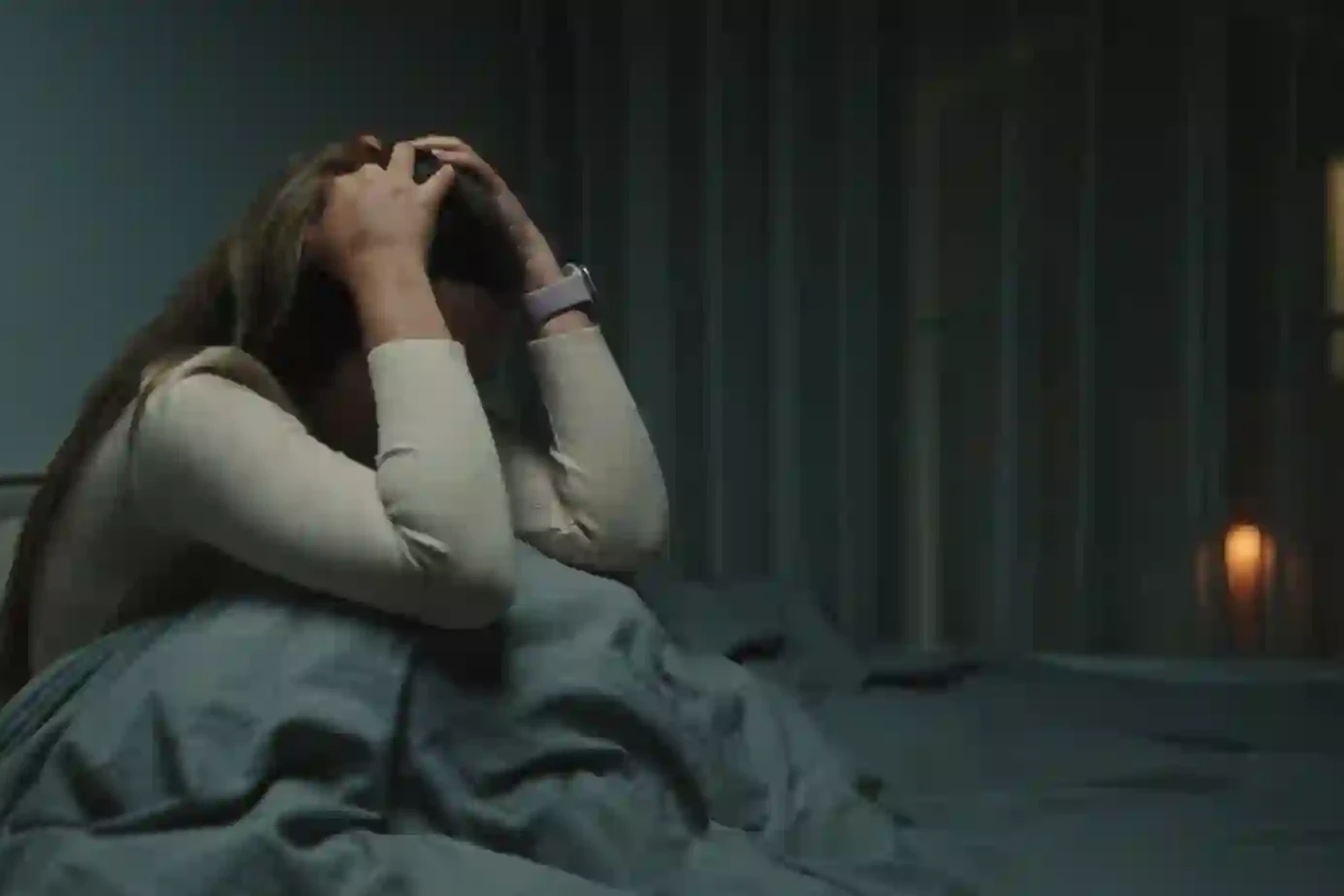Facing compression of the spinal cord can feel overwhelming. But learning the main points helps manage this condition well. Your spinal cord is a group of nerves moving messages between your brain and body. Spinal cord compression can happen from the neck to the lower back. It’s due to any issue pressing on this critical part of your body.
The signs of spinal cord compression differ a lot. You might feel numb, in pain, weak, or lose control of your bowels and bladder. How quickly these symptoms show up depends on what’s causing them. In tough cases, myelopathy might develop. This makes walking hard and causes pain and numbness.
If you face spinal cord compression, whether it hits you fast or slows, team up with your doctors. This step is crucial for the best result. Treatment can involve drugs, physical therapy, or surgery. It all depends on how bad it is and its cause. Knowing about symptoms of spinal cord compression and what to do helps you lead in your health. This can make a big difference in your life quality.
Table of Contents
ToggleWhat is Compression of the Spinal Cord?
Spinal cord compression can happen from the neck down to the lower back. Various factors can press on the spinal cord. This disrupts its function and can lead to severe symptoms.
Causes of Spinal Cord Compression
Osteoarthritis, spinal injuries, and tumors are some causes. Also, some bone diseases and spine wear and tear over time. Osteoarthritis usually affects those over 50. It causes the spine to gradually deteriorate.
Symptoms of Spinal Cord Compression
Symptoms can start fast or slowly depending on the cause. Immediate symptoms happen from spine injuries. But, gradual spine wear and tear take years to show effects. Besides pain, symptoms include numbness and coordination issues.
Acute vs. Chronic Compression
Acute compression comes suddenly, often from an injury. It needs quick medical help. Chronic compression, like osteoarthritis, develops slowly. It can be managed with several treatments. Lower back nerve pressure might lead to cauda equina syndrome. This syndrome causes severe symptoms like leg weakness and bladder control loss.

Spinal Anatomy and Function
The spinal cord is like a main road for signals between your brain and body. It’s protected by the vertebral column, which is made of 24 vertebrae, or bones. Each vertebra forms a center hole. This creates a tube that shields the spinal cord. The spine has an “S” shape to evenly hold weight and handle stress.
The Vertebral Column
The vertebral column has five parts: cervical, thoracic, lumbar, sacrum, and coccyx. The cervical spine has 7 vertebrae, the thoracic spine has 12, and the lumbar spine usually has 5. However, some people might have an extra lumbar vertebra without problems. The sacrum joins the spine to the pelvis.
The Spinal Cord
The spinal cord starts at the brain’s base and goes to just below the second lumbar vertebra. It contains nerve bundles that let your brain and body talk. This is crucial for moving, feeling, and many other body functions.
Nerve Roots and Cauda Equina
Nerve roots come from the spinal cord and pass through small openings in the vertebrae. They then connect the spinal cord to the body. The cauda equina is a bunch of nerve roots below the spinal cord. It’s key to know about these for understanding compression and its effects.
Common Causes of Spinal Cord Compression
Spinal cord compression is often caused by the normal wear and tear on the spine. This happens as people age. It includes diseases like osteoarthritis and degenerative disc disease. These affect older adults.
Other causes can be spinal injuries, trauma, and tumors. Spinal tumors can be cancerous or not. They can happen quickly and affect people at any age.
Osteoarthritis and Degenerative Disc Disease
This type of compression mainly affects those over 50. As the spinal discs wear down, they may press on the spinal cord. This causes pain, numbness, and weakness.
Spinal Injuries and Trauma
Accidents or falls can injure the spine and instantly compress the spinal cord. This situation needs urgent medical care. It can happen to anyone and cause sudden severe issues.
Spinal Tumors
Spinal tumors, whether cancerous or not, can compress the spinal cord. This leads to a variety of symptoms. For example, lung cancer and prostate cancer can cause MSCC in a small percentage of cancer patients.
Other Causes
Spinal cord compression can also come from bone diseases and infections like epidural abscess. These less common problems may show up quickly and affect people of any age.
Symptoms of Compression of the Spinal Cord
Symptoms of spinal cord compression vary with its cause and location on the spine. Despite these differences, there are common signs to watch out for.
Back and Neck Pain
Back and neck pain are common in spinal cord compression cases. You might feel sharp, dull, or burning pain. It can spread to the arms, buttocks, or legs. This pain often gets worse when moving or active.
Numbness and Weakness
Spinal cord compression can cause numbness, tingling, or weakness in your extremities. The reason is the pressure on nerve signals in your spinal cord. Feeling loss and coordination problems, including foot drop, are also classic signs.
Bowel and Bladder Dysfunction
In severe cases, like when it affects the lumbar spine, you might lose control over your bowels or bladder. This is a serious sign needing immediate medical help. It could be a cauda equina syndrome episode.
The speed and severity of these symptoms can greatly differ. Some symptoms might take years to show, while others can appear suddenly. If you notice these signs, seek medical attention promptly to avoid possible damage.
Diagnosing Spinal Cord Compression
If you have symptoms of spinal cord compression, your doctor will work hard to find the cause. They will start by talking with you and then examine you. This includes testing your nerves and muscle strength.
Physical Examination
In the exam, your provider will check your body’s nervous system. They’ll look for signs like numbness and changes in reflexes. They might test your ability to move, your muscle strength, and how you feel touch or vibration.
Imaging Tests
Next, your provider might ask for tests to see inside your body. These tests can show the spinal cord and areas near it. They include x-rays, CT scans, and MRI scans.
- X-rays, which can show abnormal bone growths or alignment issues
- CT (computed tomography) scans, which provide more detailed views of the spinal cord and vertebrae
- MRI (magnetic resonance imaging) scans, which produce high-resolution images that can reveal soft tissue damage or compression
Additional Tests
If necessary, your provider might order more tests to understand the problem better. This could include a myelogram, bone scan, or an electromyography (EMG). Each test gives different information about the spine.
- Myelogram: A dye is injected into the spinal canal, allowing for X-ray or CT imaging to identify areas of compression
- Bone scan: Detects changes in bone metabolism that could indicate underlying conditions affecting the spine
- Electromyography (EMG): Measures the electrical activity in muscles, which can help identify nerve damage or compression
All this information helps your healthcare team figure out what’s causing your spinal cord compression. With a clear diagnosis, they can then choose the best treatment for you.
Treatment Options for Spinal Cord Compression
Dealing with spinal cord compression requires special care. Treatments are chosen based on what’s causing it and how bad your symptoms are. Doctors might suggest different options for you:
Medications
Nonsteroidal anti-inflammatory drugs (NSAIDs) help with pain and swelling. Your doctor might also give you high-dose steroids to quickly lower inflammation and pressure on your spinal cord. If the compression is due to tumors, radiation therapy could be used to reduce their size and ease pressure.
Physical Therapy
Physical therapy is key in handling spinal cord compression. A therapist will lead you in exercises. These will make the muscles around your spine stronger, boost flexibility, and help with movement. You’ll also learn how to do daily tasks in a spine-safe way and keep a good posture.
Surgical Interventions
If the compression is critical or urgent, surgery might be the best step. This can involve several procedures like removing bone spurs, making space between vertebrae, or stabilizing the spine. It’s often the last option after trying other treatments first.
Your spinal cord compression treatment will be customized to your condition’s cause, where it is, and how severe it is. Your medical team will help figure out the best plan to ease your symptoms and keep your spinal cord healthy.

Preventing Spinal Cord Compression
Spinal cord compression can be hard to prevent, but there are ways to avoid its symptoms. To protect your spine from daily stress, keep a healthy weight. Also, mind your posture, lift carefully, and exercise to make your back muscles strong. Doing these things lowers your chance of having spinal cord problems.
Maintaining a Healthy Weight
Extra weight strains your spine and might lead to spinal cord compression. A good diet and regular exercise can reduce this risk. They help lessen the pressure on your back, making symptoms less likely.
Proper Posture and Lifting Techniques
Spinal cord compression can be prevented by standing and lifting correctly. Keep your back straight and use your legs, not your back, when lifting. This lessens stress on your spine, making compression problems less likely over time.
Regular Exercise and Stretching
Exercise and stretching are key for a strong spine and can cut the risk of spinal cord compression. Activities like walking, swimming, and yoga are great. They keep your spine healthy and flexible, lowering the chance of issues.

Cauda Equina Syndrome
Cauda equina syndrome (CES) is a serious condition. It’s caused by the squeezing of nerve roots at the end of the spinal cord. This pressure can cause sudden and severe problems. Quick treatment is crucial to avoid lasting nerve damage.
The main cause of CES is a large herniated disc in the lower back. This disc pushes on the nerves, leading to CES. Other reasons for CES can be spinal lesions, infections, or injuries. Birth defects, blood vessel issues, and surgery problems can also cause it.
If you notice any key symptoms of CES, like bowel or bladder issues, severe leg pain, or numbness in areas like the thighs, get emergency help. A neurosurgeon or spine doctor should see you right away. Early care is vital for preventing nerve damage and helping you get better.
CES is a health emergency often needing surgery within 24 to 48 hours. But, if surgery happens later, symptoms might still improve for some. Yet, if the nerves are severely hurt, some issues like bladder control may not get better. This could last a long time.
Having CES can really change your day-to-day life, impacting work, relationships, and mood. Medications, therapy, and support from friends can help deal with the pain. Your healthcare team and loved ones matter a lot for emotional support too.
While not common, CES affects around 1 in 65,000 people. About 60% have full CES, which may have bladder or bowel problems. The other 40% with incomplete CES might feel urgency but no issues with holding their bladder or bowels.
If you or someone you know gets CES, remember, there is support. Quick medical care, the right treatment, and support from others can improve your life. Always talk to your healthcare team for advice and support.
Managing Spinal Cord Compression
The best way to approach spinal cord compression is by working with your healthcare team. They may include orthopedists, neurologists, and physical therapists. Together, you can create a plan to deal with the root cause and control your symptoms.
Working with Healthcare Providers
Your healthcare team is key in managing your condition. They will explain what’s causing your spinal cord compression and suggest treatments. It’s important to talk openly with them about how you feel and any changes you notice.
Self-Care and Lifestyle Modifications
Alongside medical treatments, there are things you can do on your own to help. Keeping a healthy weight, having good posture, and exercising regularly can reduce stress on your spine. These habits are crucial for managing your condition.
Complementary Therapies
Some people might get relief from acupuncture or chiropractic care. It’s important that these treatments are in addition to, not instead of, what your doctor advises. Always check with your healthcare team before starting any complementary therapy.
When to Seek Emergency Care
If you suddenly can’t control your bowel or bladder, or feel severe numbness in your legs, you need to act fast. This includes having difficulty walking due to leg pain or weakness. Don’t delay seeking help. Untreated, these conditions can cause permanent nerve damage.
Spinal cord issues might start fast, after an accident, or slowly with time. The cause can be anything from injuries to the regular wear and tear on your back. When the nerves in the lower back are affected, a situation like cauda equina syndrome can happen. This needs immediate treatment usually in the ER.
Doctors use CT scans or MRIs to figure out what’s going on with your spine. They give a clear view of the problem. Treating spinal cord problems often means a group of experts working together. They might use drugs, PT, injections, or sometimes, surgery.
If you have any worrying signs, going to the ER right away is key. Quick action can avoid lasting nerve damage and keep you well. Don’t wait if you have symptoms that seem related to spinal cord issues.
Living with Spinal Cord Compression
Living with spinal cord compression can be tough, both physically and emotionally. Yet, with the right support, you can boost your life quality. This involves being actively involved in your treatment and care.
Emotional and Psychological Support
It’s crucial to understand the emotional impact of spinal cord compression. Dealing with physical limits, pain, and a potential loss of freedom can affect your mental well-being. Getting help through counseling or support groups can improve your mental health and teach healthy ways to cope.
Assistive Devices and Modifications
Using tools and adapting your home can help you stay independent and safe. Things like braces, walkers, or ramps make daily life easier. They help with moving around and lower the chance of accidents.
Support Groups and Resources
Finding a support group can make a big difference. It lets you connect with people who understand what you’re going through. Sharing tips and experiences with others can be very helpful. Also, online resources provide valuable info to help you manage your situation.
Key Takeaways
The key points about spinal cord compression are:
- Any issue that squeezes the spinal cord can lead to problems.
- You might start feeling symptoms suddenly or over time. These can be pain, numbness, weakness, and trouble controlling your bladder or bowels.
- Reasons for compression include osteoarthritis, injuries, tumors, and certain diseases.
- Doctors use a physical checkup, scans, and sometimes other tests to find out what’s wrong.
- Treatments can be medicine, physical therapy, or even surgery, based on the reason and how severe it is.
- Living a healthy life might lower your risk or ease symptoms, but not all causes can be stopped.
- It’s very important to get help quickly if you have severe symptoms. This can stop lasting damage to your nerves.
Knowing these main points about spinal cord compression is crucial. It helps you spot the signs, get the right care, and work on dealing with this issue. With teamwork between you and your healthcare team, along with good habits, you can make a big difference in your health and future.
Conclusion
Compression of the spinal cord is a severe issue that affects health and life quality. It’s important to know the causes, symptoms, and how it’s diagnosed and treated. This knowledge helps in recognizing when to see a doctor and how to manage it. Working with healthcare professionals, adopting healthy habits, and getting support is key.
Learning more about spinal cord compression helps improve care and support for those with it. Several conditions can cause it, such as cervical spondylosis or a spinal epidural abscess. This shows the need to stay educated and take an active role in your health. By taking the right steps, living with spinal cord compression can be less challenging. You can focus on staying well.
FAQ
What is spinal cord compression?
Spinal cord compression happens when other conditions put pressure on your spinal cord. This cord is a bunch of nerves moving messages from your brain to everywhere else. It can be from your neck down to your lower back.
What causes spinal cord compression?
Various things can cause your spinal cord to get compressed. These include osteoarthritis, spinal injuries, tumors, and certain bone diseases.
What are the symptoms of spinal cord compression?
You might feel pain in your back or neck and have numbness and weakness. There could also be problems with your bowel or bladder. How serious and fast these symptoms appear depends on the cause.
How is spinal cord compression diagnosed?
To find out if you have spinal cord compression, your doctor will talk to you and examine you. They’ll also use X-rays, CT scans, and MRIs to get a closer look.
How is spinal cord compression treated?
The treatment changes based on how bad your symptoms are and what’s causing them. You might need medicine, physical therapy, or even surgery.
Can spinal cord compression be prevented?
It’s hard to prevent all cases of spinal cord compression. But, keeping a healthy weight, good posture, and regular exercise can lower your risk.
What is cauda equina syndrome?
This is a serious issue where the nerve roots at the end of your spinal cord get compressed. It needs to be treated right away to prevent permanent damage.
When should I seek emergency care for spinal cord compression?
Go to the ER if you suddenly can’t control your bowel or bladder, get increasing numbness in your legs, have severe leg pain and weakness, or have trouble walking or standing up.
How can I manage daily life with spinal cord compression?
Work closely with your healthcare team and take care of yourself. Using devices to help, and finding emotional support is important.
Source Links
- https://www.hopkinsmedicine.org/health/conditions-and-diseases/spinal-cord-compression
- https://www.ncbi.nlm.nih.gov/books/NBK557604/
- https://www.urmc.rochester.edu/encyclopedia/content.aspx?ContentTypeID=134&ContentID=13
- https://www.umms.org/ummc/health-services/orthopedics/services/spine/patient-guides/anatomy-function
- https://spinehealth.org/article/spine-anatomy/
- https://www.cancerresearchuk.org/about-cancer/coping/physically/spinal-cord-compression/treatment
- https://www.aans.org/en/Patients/Neurosurgical-Conditions-and-Treatments/Cauda-Equina-Syndrome
- https://my.clevelandclinic.org/health/diseases/22132-cauda-equina-syndrome
- https://www.aafp.org/pubs/afp/issues/2001/0815/p631.html
- https://www.cancerresearchuk.org/about-cancer/coping/physically/spinal-cord-compression/about
About The Author

This article is medically reviewed by Dr. Chandril Chugh, Board-Certified Neurologist, providing expert insights and reliable health information.
Dr. Chandril Chugh is a U.S.-trained neurologist with over a decade of experience. Known for his compassionate care, he specializes in treating neurological conditions such as migraines, epilepsy, and Parkinson’s disease. Dr. Chugh is highly regarded for his patient-centered approach and dedication to providing personalized care.
→ Book a consultation to discover which remedies suit your needs best.




